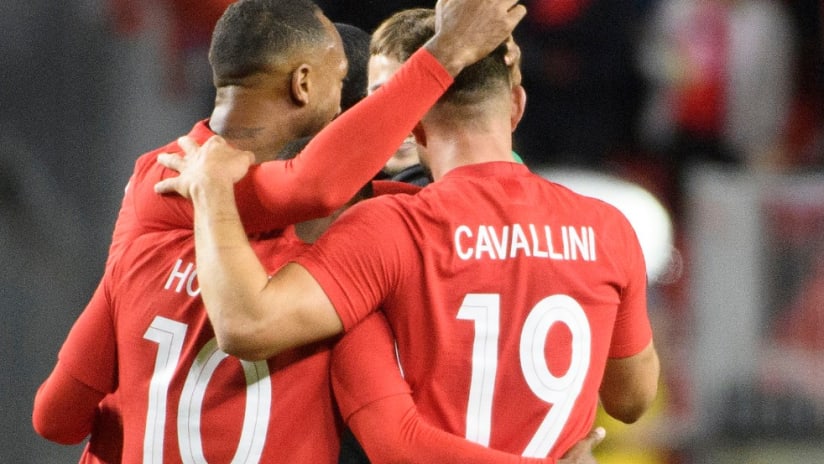It has been 34 years since the Canadian men's national team beat the US men's national team. It's been 39 years since Canada beat the US in a competitive game. The gap had been widening for years. Now, however, it feels closer than ever.
When the two teams meet on Tuesday night in the Concacaf Nations League (7:30 pm ET | ESPN2, UniMás, TUDN in US; OneSoccer in Canada), there's a new sense that Canada could upset the United States, fueled by more optimism up north and more consternation in the States than we've seen in a generation.
It's the biggest game of the Gregg Berhalter era — larger than either game with Mexico, including the Gold Cup final. Everyone knows the USMNT is behind Mexico right now. Berhalter and his group had nothing to lose in those games. It's easier to lose a game you're supposed to lose than to fall to a team you have overpowered for three straight decades.
Is Canada's roster as good as the US lineup right now? No. But they are certainly close enough to cause problems. Alphonso Davies, Jonathan David and Mark-Anthony Kaye would all probably start for the US; another two or three would be somewhere in the picture. The only piece really holding Canada back from going toe-to-toe with the US is their back four.
With all of that in mind, how can Canada find a win at Toronto's BMO Field on Tuesday night?
Be disruptors
Sometimes you want to go into a game and outplay the other team (or at least attempt to outplay them). Other times you don't need to outplay the opponent; you only need to stop them from playing their game. Canada only need to do the second one on Tuesday night.
The value of Berhalter's detail-oriented system is that it limits variables and tries to make an inherently random sport more predictable. The opposite to that, then, is playing in chaos. The more a team prefers to make the game logical, the less they like — and understand how — to play in a game that doesn't make sense. It's against those opponents when you simply want to blow up the game. You don't need to win the soccer game; you simply need to make the soccer game chaotic and win the chaos (LAFC have been dealing with this scenario for the last 10 games of the season).
Canada head coach John Herdman alluded to just this over the weekend: “The Mexicans have a very deliberate style and an intensity in how they just won’t let Berhalter’s machine settle into a rhythm. That’s how I’ve seen [the US] develop. They’re like a well-oiled machine: everything works off a trigger, off a cue, and if you’re able to disrupt that rhythm then the team struggles...Mexico just unsettle them.”
Everyone uses some adage of, "we need to be hard to play against," but it takes a real sense of self — or for professional players, releasing of the self — in order to pull it off. Professional players want to play soccer; they enjoy passing and dribbling and moving. Their natural gratification system comes from soccer actions. Few professional players want to play against the ball. But when your gameplan involves acting as the disruptors, you need to switch that. You need to forgive yourself for giveaways or bad touches and base your performance on cutting out passing lanes, winning tackles and closing down the ball. That little switch in the brain provides the extra 1% of decisiveness and quickness in actions.
Disrupt the right way
The subsequent question then becomes: What's the best way to disrupt the US' system? Does playing 'against the ball' mean you have to press? I would say no.
You can't press without elite center backs. If you spread your lines to press, you leave the center backs with a ton of space to cover. Canada's center backs aren't suited for that. We saw the USMNT overplay in the back against Mexico in September and not test Mexico's center backs. It'd be surprising to see the US take the same method this week; if Canada press, expect the USMNT to be ready to play over the first wave and exploit the space behind and between Canada's defensive lines.
Instead of pressing, Canada need to use an active middle block (I made this term up). Most middle blocks start around midfield and aim to keep play in front of them; it's a reactive defensive strategy. An active middle block is a press that gets initiated closer to midfield. For example, RB Leipzig, a team known for pressing, often use an active middle block. They start compact and then go gung ho when the ball passes a certain point.
The active middle block has the same goal in mind as a high press — making the opponent uncomfortable and forcing turnovers — from a more compact, lower-risk starting position.
It's the best way for Canada to use the US' own system against them without leaving their own center backs exposed.
Frustrate Pulisic
Here's one of those things that sucks to type but there's no way to write this story without saying it: You need to make contact with Christian Pulisic early and often. Sometimes you have to take the foul when Pulisic gets space, as Mexico did when the teams met at MetLife in September. More often, you need to get in little nudges before Pulisic gets the ball or after he releases the ball, as Costa Rica did in 2018 World Cup qualifying. Some star players take those fouls as a compliment and use them as fuel; Pulisic, so far in his young USMNT career, has mostly become frustrated and thrown off his game. Many call it a cheap tactic; others call it part of the game. It's a moot conversation because it's legal and used by winners across the world.
Go!
The biggest weakness in the US team right now, both tactically and within their personnel, is defensive transitions. When the US lose the ball, they are vulnerable. Conversely, Canada's attack is very good at attacking transitions. Davies, David and Junior Hoilett in space is not something any defender wants to see. The more Canada can get the ball forward quickly in the transition, the more dangerous they will be.













